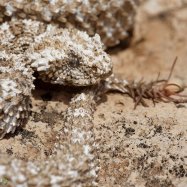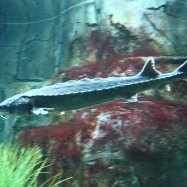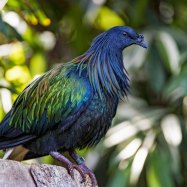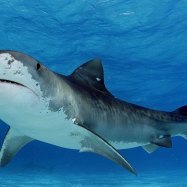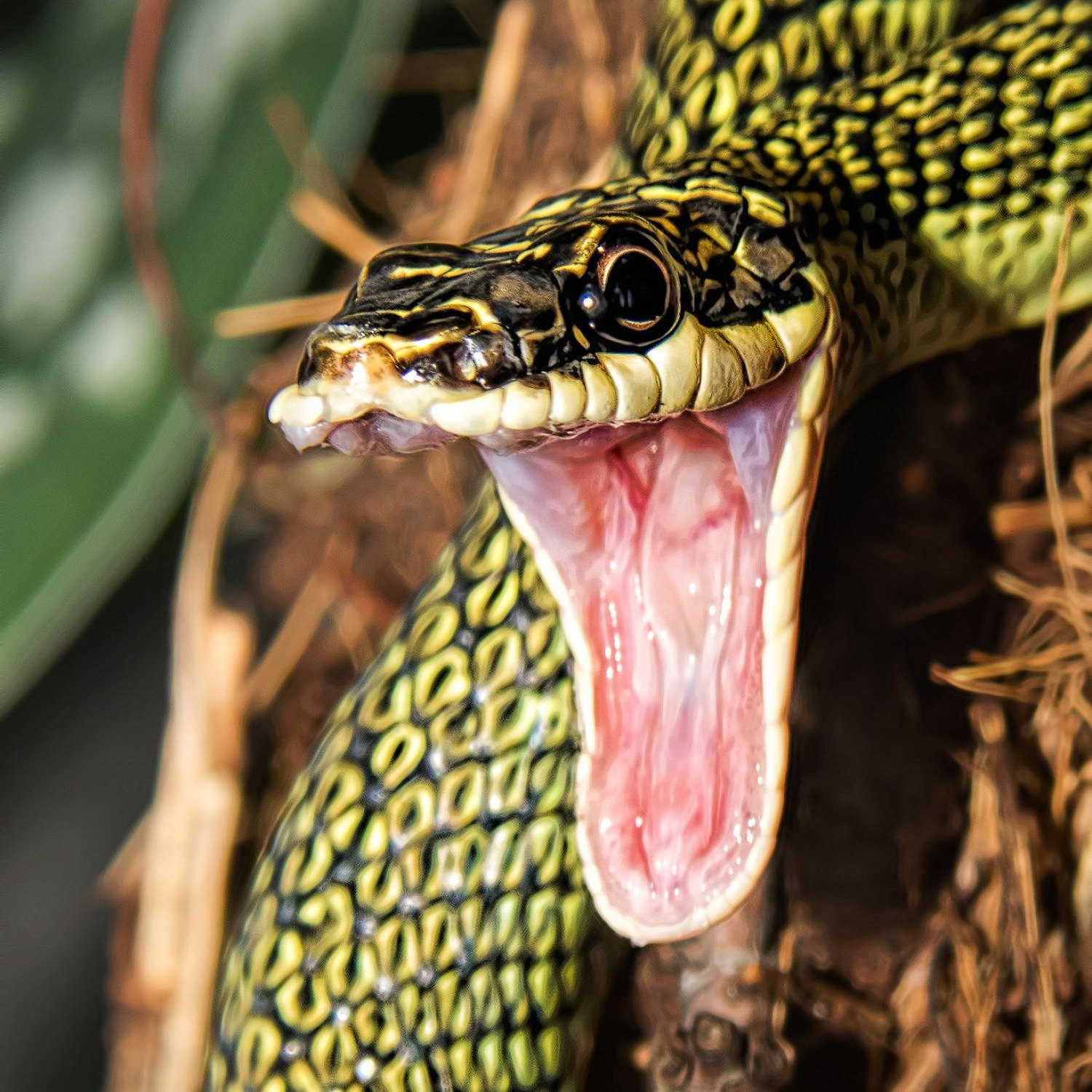
Flying Snake
Up to 4.5 feet
. Meet the Flying Snake, an incredible creature that makes its home in the treetops and forest canopies. This non-venomous snake, belonging to the Colubridae family, can grow up to 4.5 feet in length and has a long and slender body. With its unique ability to glide through the air, it's no wonder this animal has earned its name. Discover more about this fascinating species and its amazing adaptations. #FlyingSnake #Animals #Nature
Animal Details Summary:
Common Name: Flying Snake
Kingdom: Animalia
Habitat: Forests
The Fascinating World of the Flying Snake
Imagine walking through a dense forest in Southeast Asia and suddenly coming across a snake gliding through the air. Sounds like a scene straight out of a fantasy movie, right? But did you know that such a snake actually exists in real life?Meet the flying snake, scientifically known as Chrysopelea and commonly referred to as the flying snake. This unique and fascinating reptile is a perfect example of how evolution can create extraordinary adaptations for survival. In this article, we will explore the incredible features of this animal and its life in the wild Flying Snake.
The Kingdom, Phylum, Class, and Order of the Flying Snake
The kingdom Animalia comprises all animals, including humans and flying snakes. The flying snake belongs to the phylum Chordata, which includes animals with a backbone or spinal cord. In the class Reptilia, the flying snake is part of the order Squamata, which includes lizards, snakes, and amphisbaenians.The Family and Habitat of the Flying Snake
The flying snake belongs to the family Colubridae, which is one of the most diverse and widespread families of snakes. These snakes can be found in various countries in Southeast Asia, including Thailand, Malaysia, Indonesia, and the Philippines. Their preferred habitat is forests, where they can find an abundant supply of prey and trees to glide from.The Feeding Method of the Flying Snake
The flying snake is carnivorous, meaning it feeds on other animals. Its diet primarily consists of lizards, frogs, and small mammals. The hunting technique of the flying snake is quite unique and impressive Frug. It uses its long, slender body to climb trees and reach its prey. Once it spots its target, it will launch itself into the air and glide towards the prey. Its sleek and aerodynamic body allows it to move effortlessly through the air, and it can cover a distance of up to 100 feet in a single glide.The Geographical Distribution and Country of Origin of the Flying Snake
As mentioned earlier, the flying snake is primarily found in Southeast Asia, specifically in countries like Thailand, Malaysia, Indonesia, and the Philippines. However, due to the low population density and elusive nature of these snakes, their exact distribution is still not fully known. These snakes are also found in the tropical rainforests of India, Sri Lanka, and southern China.The Location of the Flying Snake
The flying snake spends most of its time high up in the trees and forest canopies. Its slender body and excellent climbing abilities allow it to move swiftly between branches and tree trunks. However, they are also known to come down to the forest floor to bask in the sun or hunt for prey. They are most active during the day and retreat to the safety of the trees at night.The Animal Coloration of the Flying Snake
The flying snake's coloration is a unique and fascinating aspect of its appearance. They have a smooth and glossy body that can vary in color from dark green to brown, with speckles of black and white. This coloration allows them to blend seamlessly into the forest surroundings, making them difficult to spot by predators or prey.The Body Shape and Length of the Flying Snake
Compared to other snakes, the flying snake has a unique body shape that is long and slender. Its body is also flattened, which gives it the ability to glide through the air. These snakes can grow up to 4.5 feet in length, which allows them to cover a significant distance during their glides.The Incredible Flying Abilities of the Flying Snake
One of the most remarkable features of the flying snake is, of course, its ability to glide through the air. But how exactly does it do it? Well, the flying snake has a unique adaptation that allows it to use its body as a gliding membrane. Just before launching itself into the air, the snake will flatten its body, making it twice as wide as usual. At the same time, it will curl its tail upwards, creating a concave shape, and it will slightly angle its head downwards. This shape, combined with a wave-like motion of its body, creates an aerodynamic surface that increases its lift and allows it to glide through the air.According to researchers, when the flying snake is in action, its body forms the shape of the letter "J," allowing it to generate enough lift to glide. The snake also uses its undulating motion to steer and adjust its direction during the glide. This unique adaptation has allowed the flying snake to cover distances of up to 100 feet or more in a single glide, making it one of the farthest gliding animals in the world.
Another impressive feat of the flying snake is its ability to control its glide, even in mid-air. It can adjust the width of its body or change the angle of its head to steer and land accurately on a desired target. This incredible skill is essential for its survival, as it allows the snake to avoid obstacles and land on branches to continue hunting or escape from predators.
The Science Behind the Flying Abilities of the Flying Snake
The flying snake's ability to glide is not just a random occurrence. Instead, it is a result of millions of years of evolution and natural selection. Researchers believe that the shape of the flying snake's body, as well as its undulating motion, were gradually developed through generations of snakes gliding through the air. As the snakes with better gliding abilities survived and passed on their genes, the adaptations for gliding became more refined and advanced.Another reason behind the flying snake's unique abilities could be its habit of living in trees. Trees offer a more significant challenge to gliding than open spaces, as the branches and leaves can block the snake's path. Therefore, only the snakes that could control their glides and accurately land on branches for food or safety were able to survive and reproduce.
The Challenges of Being a Flying Snake
Even though gliding through the air may seem like an easy and effortless task for the flying snake, it does face certain challenges. One of the biggest challenges is the risk of collision or getting entangled in branches or vegetation during the glide. To prevent this, the flying snake has to be highly skilled in controlling its glide and adjusting its body shape and angle in mid-air.Additionally, as mentioned earlier, the flying snake's ability to glide is a result of evolution and natural selection. Therefore, it is a skill that requires constant practice and refinement. Baby flying snakes are not born with the ability to glide perfectly; they learn and improve their skills with each glide. As a result, the survival rate of baby flying snakes is lower compared to adults, as they have not yet mastered their gliding abilities.
In Conclusion
The flying snake is one of the most remarkable and unique animals in the world, and its ability to glide through the air has captivated researchers and nature enthusiasts alike. From its incredible adaptations and flying abilities to the challenges it faces in the wild, the flying snake is a testament to the wonders of evolution. Its presence in Southeast Asian forests is a reminder of the diversity and beauty of the animal kingdom. So, the next time you go for a walk in a lush green forest, keep your eyes peeled for a gliding snake, and you might just witness the magic of the flying snake in action.

Flying Snake
Animal Details Flying Snake - Scientific Name: Chrysopelea
- Category: Animals F
- Scientific Name: Chrysopelea
- Common Name: Flying Snake
- Kingdom: Animalia
- Phylum: Chordata
- Class: Reptilia
- Order: Squamata
- Family: Colubridae
- Habitat: Forests
- Feeding Method: Carnivorous
- Geographical Distribution: Southeast Asia
- Country of Origin: Various countries in Southeast Asia
- Location: Trees and forest canopies
- Animal Coloration: Varies (often green or brown)
- Body Shape: Long and slender
- Length: Up to 4.5 feet
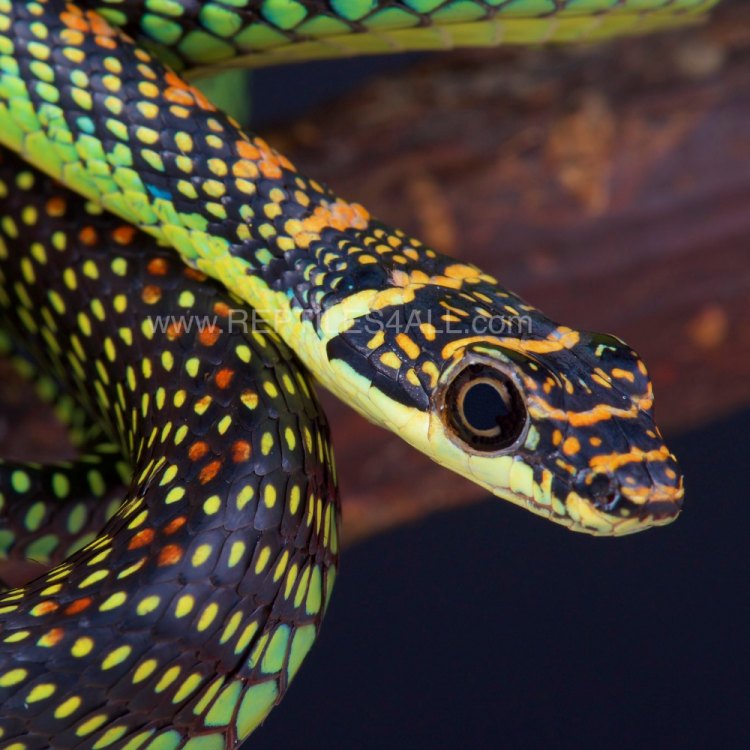
Flying Snake
- Adult Size: Medium-sized
- Average Lifespan: Unknown
- Reproduction: Egg-laying
- Reproductive Behavior: Males compete for females during mating season
- Sound or Call: None
- Migration Pattern: Non-migratory
- Social Groups: Solitary
- Behavior: Arboreal and diurnal
- Threats: Habitat loss and fragmentation, hunting
- Conservation Status: Not evaluated
- Impact on Ecosystem: Unknown
- Human Use: None
- Distinctive Features: Ability to glide through the air
- Interesting Facts: Flying snakes can glide between trees by flattening their bodies and using their rib muscles to propel themselves forward.
- Predator: Birds of prey, large reptiles
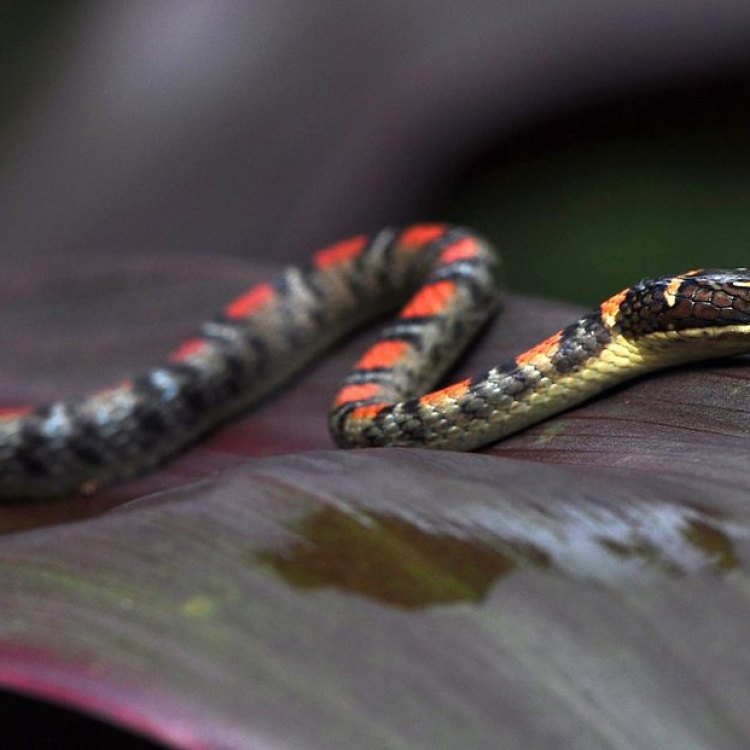
Chrysopelea
The Flying Snake: A Unique and Enigmatic Creature
In the dense forests of Southeast Asia, there is a creature that has captured the fascination of scientists and nature enthusiasts alike - the flying snake. This medium-sized reptile, also known as the Chrysopelea, is not your typical snake. Its remarkable ability to glide through the air has earned it a place in the annals of nature's most incredible adaptations.But what exactly makes this creature so unique? Let's delve into its world and uncover the elusive and mysterious traits of the flying snake PeaceOfAnimals.Com.
A Medium-Sized Marvel
The flying snake, as its name suggests, is not your average slithering serpent. It is a medium-sized snake, typically measuring between 1 and 1.5 meters in length. Its slender body and long, flat tail give it a graceful and elegant appearance, making it a sight to behold in its natural habitat.The Unknown Lifespan
One of the most intriguing aspects of the flying snake is its lifespan. However, despite numerous studies, scientists have not been able to determine the average lifespan of this elusive creature. Due to its solitary nature and preference for living in remote forests, it is challenging to track and study the flying snake in the wild.Egg-Laying Reproduction and Mating Behavior
Like most snakes, the flying snake reproduces by laying eggs. Females typically lay a clutch of 4-7 eggs, which they carefully coil and guard until they hatch Furrow Bee. Interestingly, the mating behavior of these snakes is quite unique. During the mating season, male flying snakes engage in a competitive ritual to win the attention of a potential mate. This behavior involves intertwining their bodies and contorting in intricate ways to impress the female.The Silent Gliding Master
One of the most distinctive and fascinating features of the flying snake is its ability to glide through the air. Unlike other flying animals, such as birds or bats, flying snakes do not have wings. Instead, they use their incredible body structure and specialized muscles to glide gracefully between trees.To achieve this feat, the flying snake flattens its body and extends its ribs, essentially turning its body into a flat, aerodynamic surface. It then uses its powerful rib muscles to propel itself forward, sometimes covering a distance of up to 100 meters in a single glide. This unique adaptation allows the snake to escape predators, cover large distances quickly, and hunt more efficiently.
Arboreal and Diurnal Behavior
The flying snake's preferred habitat is the dense, canopied forests of Southeast Asia. It is an arboreal species, meaning it spends most of its life in trees. Its diurnal behavior, or being active during the day, is another characteristic that sets it apart from most snakes, which are often nocturnal.The flying snake spends its days basking in the sun and hunting for prey, such as small birds and lizards. Once it has had its fill, it retreats to the safety of the trees, often coiling itself around a branch and blending into its surroundings.
Threats to the Flying Snake
Like most animals, the flying snake faces numerous threats in its natural habitat. Habitat loss and fragmentation due to deforestation are the biggest threats to this species. As human activity continues to encroach on their territory, the flying snake's population is declining.Additionally, the flying snake is hunted and sold in the illegal wildlife trade for its stunning skin and unique abilities. This ongoing exploitation is causing a significant decline in the species' numbers.
Conservation Status and Impact on Ecosystem
Despite being a fascinating and enigmatic creature, the flying snake's conservation status has not been evaluated by the International Union for Conservation of Nature (IUCN). However, given the destruction of their habitat and the increasing demand for them in the illegal wildlife trade, it is likely that their numbers are dwindling.The flying snake's impact on the ecosystem is not well understood, as research on its role in the ecosystem is limited. However, as a predator of small birds and lizards, it may play a role in controlling their populations, contributing to a balanced ecosystem.
Humans and the Flying Snake
For centuries, the flying snake has remained a mysterious and elusive creature, with little to no interaction with humans. They are not kept as pets and are not used for any purpose by humans, making them one of the few animals that are entirely untouched by human influence.However, the ongoing destruction of their habitat and illegal trade pose a significant threat to their survival. It is essential for humans to recognize the value and uniqueness of this species and take steps to protect and preserve their habitat.
Predators
Despite its incredible gliding abilities, the flying snake is not entirely immune to predators. Birds of prey, such as hawks and eagles, are known to feed on these snakes, as well as large reptiles like monitor lizards. To evade these predators, the flying snake uses its gliding abilities to escape into the safety of the trees.Interesting Facts about the Flying Snake
Apart from its remarkable gliding ability, the flying snake boasts many other interesting facts that make it a fascinating and enigmatic creature. Here are a few intriguing facts about this unique species:- The flying snake has been observed to glide both forwards and backward.
- It has color-changing abilities, with some individuals having bright yellow or reddish-orange coloration on their undersides to blend into their surroundings.
- The flying snake is mildly venomous, with its venom mainly used for subduing prey. However, its venom is not considered harmful to humans.
- Its scientific name, Chrysopelea, comes from the ancient Greek words "chrysos," meaning gold, and "pelea," meaning darkness. This name reflects the snake's stunning, contrasting coloration.
- The flying snake's gliding ability has inspired the creation of flying robots, mimicking its unique body structure and muscles.
In Conclusion
The flying snake is undoubtedly a unique and enigmatic creature, possessed of adaptations that have allowed it to thrive in its dense, forested home. Its ability to soar effortlessly through the air is a marvel of nature, and one that continues to inspire scientists to this day.However, this magnificent species is under threat, and it is up to humans to protect and preserve its habitat to ensure its survival for future generations. Let us appreciate the fascinating wonders of the natural world and protect the creatures that make it truly extraordinary.
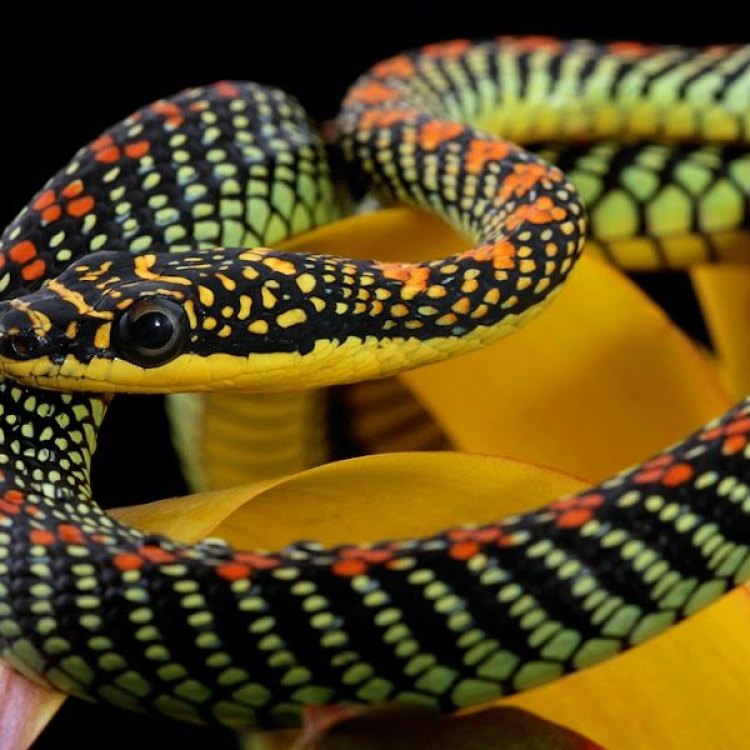
The Fascinating World of the Flying Snake
Disclaimer: The content provided is for informational purposes only. We cannot guarantee the accuracy of the information on this page 100%. All information provided here may change without prior notice.

